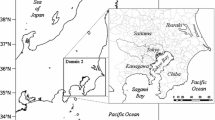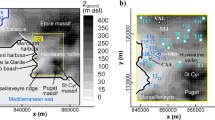Abstract
Field data are analyzed in order to study the development of the Thermal Internal Boundary Layer (TIBL) under sea breeze conditions. The measurements were carried out by the National Observatory of Athens (NOA) during ATHens Internal Boundary Layer Experiment (ATHIBLEX) in summer 1989 and 1990.
Several formulations found in the literature are tested against the measurements in order to investigate whether they are capable of predicting the depth of the TIBL. It is found that a slab model including mechanical production of turbulence gives overall good agreement with the measurements.
Finally, the concept of local equilibrium is used to explain the discrepancies found between small-and meso-scale observations and models; a formula is proposed which is intended for use over a wide range of downwind fetches.
Similar content being viewed by others
Referneces
Arritt, R. W.: 1987, ‘Effect of Water Surface Temperature on Lake Breezes and Thermal Internal Boundary Layers’,Boundary-Layer Meteorol. 40, 101–125.
Bergström, H.: 1986, ‘A Simplified Boundary-Layer Wind Model for Practical Application’,J. Appl. Meteorol. 25, 813–824.
Bergström, H., Johansson, P. E., and Smedman, A. S.: 1988, ‘A Study of Wind Speed Modification and the Internal Boundary-Layer Heights in the Coastal Region’,Boundary-Layer Meteorol. 42, 313–335.
Berkowicz, R., and Olesen, H. R.: 1990, ‘Modeling the Internal Boundary Layer at a Coastal Site’,Proc. from Ninth Symposium on Turbulence and Diffusion, April 30–May 3, 1990, Risö, Denmark, Amer. Meteorol. Soc. pp. 29–30.
Chang, S. S., and Braham, R. R., Jr.: 1990, ‘Observational Study of the Development of a Snow-Producing Convective Internal Boundary Layer over Lake Michigan’,Proc. from Ninth Symposium on Turbulence and Diffusion, April 30–May 3, 1990, Risö, Denmark, Amer. Meteorol. Soc. 29–30.
Durand, P., Briere, S., and Druilhet, A.: 1989, ‘A Sea-Land Transition Observed during COAST Experiment’,J. Atmos. Sci. 46, 96–116.
Gamo, M., Yamamoto, S., and Yokoyama, O.: 1982, ‘Airborne Measurements of Free Convective Internal Boundary-Layer during the Sea Breeze’,J. Meteorol. Soc. of Japan,60, 1284–1298.
Gamo, M., Yamamoto, S., Yokoyama, O., and Yoshikado, H.: 1983, ‘Structure of the Free Convective Internal Boundary Layer Above the Coastal Area’,J. Meteorol. Soc. of Japan,61, 110–124.
Garratt, J. R.: 1990, ‘The Internal Boundary Layer — A Review’,Boundary-Layer Meteorol. 50, 171–203.
Gryning, S. E., and Batchvarova, E.: 1990, ‘Analytical Model for the Growth of the Coastal Internal Boundary Layer During Onshore Flow’,Quart. J. R. Met. Soc. 116, 187–203.
Hanna, S. R.: 1987, ‘An Empirical Formula for the Height of the Coastal Internal Boundary Layer’,Boundary-Layer Meteorol. 40, 205–207.
Hsu, S. A.: 1986, ‘A Note on Estimating the Height of the Convective Internal Boundary Layer Near Shore’,Boundary-Layer Meteorol. 35, 311–316.
Hunt, J. C. R., and Simpson, J. E.: 1982, ‘Atmospheric Boundary Layers over Nonhomogeneous Terrain’, in E. Plate (ed.)Engineering Meteorology.
Högström, U. and Smedman, A. S.: 1984, ‘The Wind Regime in Coastal Areas with Special Reference to Results Obtained from the Swedish Wind Energy Program’,Boundary-Layer Meteorol. 30, 351–373.
Johansson, P. E.: 1990, ‘Detailed Observations of the Turbulent Structure Through the Depth of an Internal Boundary Layer’,Proc. from Ninth Symposium on Turbulence and Diffusion, April 30–May 3, 1990, Risö, Denmark, Amer. Meteorol. Soc., pp. 29–30.
Kerman, B. R., Mickle, R. E., Portelli, R. V., and Trivett, N. B.: 1982, ‘The Nanticoke Shoreline Diffusion Experiment, June 1978 Internal Boundary Layer Structure’,Atmos. Env. 16, 423–437.
Melas, D.: 1990a, ‘A Field Study of the Layer-Averaged Winds in the Unstable Planetary Boundary Layer’, Ph.D. Thesis, Part V. Department of Meteorology, Uppsala University.
Melas, D.: 1990b, ‘Sodar Estimates of the Surface Heat Flux and Mixed Layer Depth Compared with Direct Measurements’,Atmospheric Environment 24A, 2847–2853.
Melas, D.: 1991, ‘Using a Simple Resistance Law to Estimate Friction Velocity from Sodar Measurements’,Boundary-Layer Meteorol. 57, 275–287.
Ogawa, Y. and Ohara, T.: 1985, ‘The Turbulent Structure of Internal Boundary Layer Near the Shore’,Boundary-Layer Meteorol. 32, 39–56.
Panofsky, H. A., and Dutton, J. A.: 1984,Atmospheric Turbulence, John Wiley & Sons, pp 397.
Pasquill, F.: 1972, ‘Some Aspects of Boundary-Layer Description’,Quart. J. Roy. Meteorol. Soc. 98, 468–494.
Raynor, G. S., Michael, P., Brown, R. M., and SethuRaman, S.: 1975, ‘Studies of Atmospheric Diffusion from a Nearshore Oceanic Site’,J. Appl. Meteorol. 14, 1080–1094.
Raynor, G. S., SethuRaman, S., and Brown, R. M.: 1979, ‘Formation and Characteristics of Coastal Internal Boundary Layers during Onshore Flows’,Boundary-Layer Meteorol. 16, 487–514.
Sethuraman, S. and Cermak, J. E.: 1974, ‘Mean Temperature Distributions over a Physically Modelled Three-Dimensional Heat Island for Different Stability Conditions’,Symposium on Atmospheric Diffusion and Air Pollution, Santa Barbara, Calif., pp. 381–386.
Smedman, A. S., and Högström, U.: 1978, ‘A Practical Method for Determining Wind Frequency Distribution for the Lowest 200 m from Routine Meteorological Data’,J. Appl. Meteorol. 7, 942–954.
Smedman, A. S., and Högström, U.: 1983, ‘Turbulent Characteristics of a Shallow Convective Internal Boundary Layer’,Boundary-Layer Meteorol. 25, 271–287.
Steyn, D. G., and Oke, T. R.: 1982, ‘The Depth of the Daytime Mixed Layer at Two Coastal Sites: a Model and its Validation’,Boundary-Layer Meteorol. 24, 161–180.
Stull, R. B.: 1988,An Introduction to Boundary Layer Meteorology, Atmospheric Sciences Library, Kluwer Academic Publishers, Dordrecht, The Netherlands, 666 pp.
Stunder, M. and Sethuraman, S.: 1985, ‘A Comparative Evaluation of the Coastal Internal Boundary-Layer Height Equations’,Boundary-Layer Meteorol. 32, 177–204.
Vachalek, R. E.: 1987, ‘Case Studies of Divergence and Vertical Velocities Calculated Using Different Sensing Systems’, M.S. thesis, University of Wisconsin, Madison, 176 pp.
Venkatram, A.: 1977, ‘A Model of Internal Boundary Layer Development’,Boundary-Layer Meteorol. 11, 419–437.
Venkatram, A.: 1986, ‘An Examination of Methods to Estimate the Height of the Coastal Internal Boundary Layer’,Boundary-Layer Meteorol. 36, 149–156.
Weisman, B.: 1976, ‘On the Criteria for the Occurrence of Fumigation Inland from a Large Lake —A Reply’,Atmos. Env. 12, 172–173.
Wyngaard, J. C.: 1983, ‘Lectures on the Planetary Boundary Layer’, in D. K. Lilly and T. Gal-Chen (eds.),Mesoscale Meteorology: Theories, Observations, and Models, D. Reidel, Dordrecht, The Netherlands.
Author information
Authors and Affiliations
Rights and permissions
About this article
Cite this article
Melas, D., Kambezidis, H.D. The depth of the internal boundary layer over an urban area under sea-breeze conditions. Boundary-Layer Meteorol 61, 247–264 (1992). https://doi.org/10.1007/BF02042934
Accepted:
Issue Date:
DOI: https://doi.org/10.1007/BF02042934




